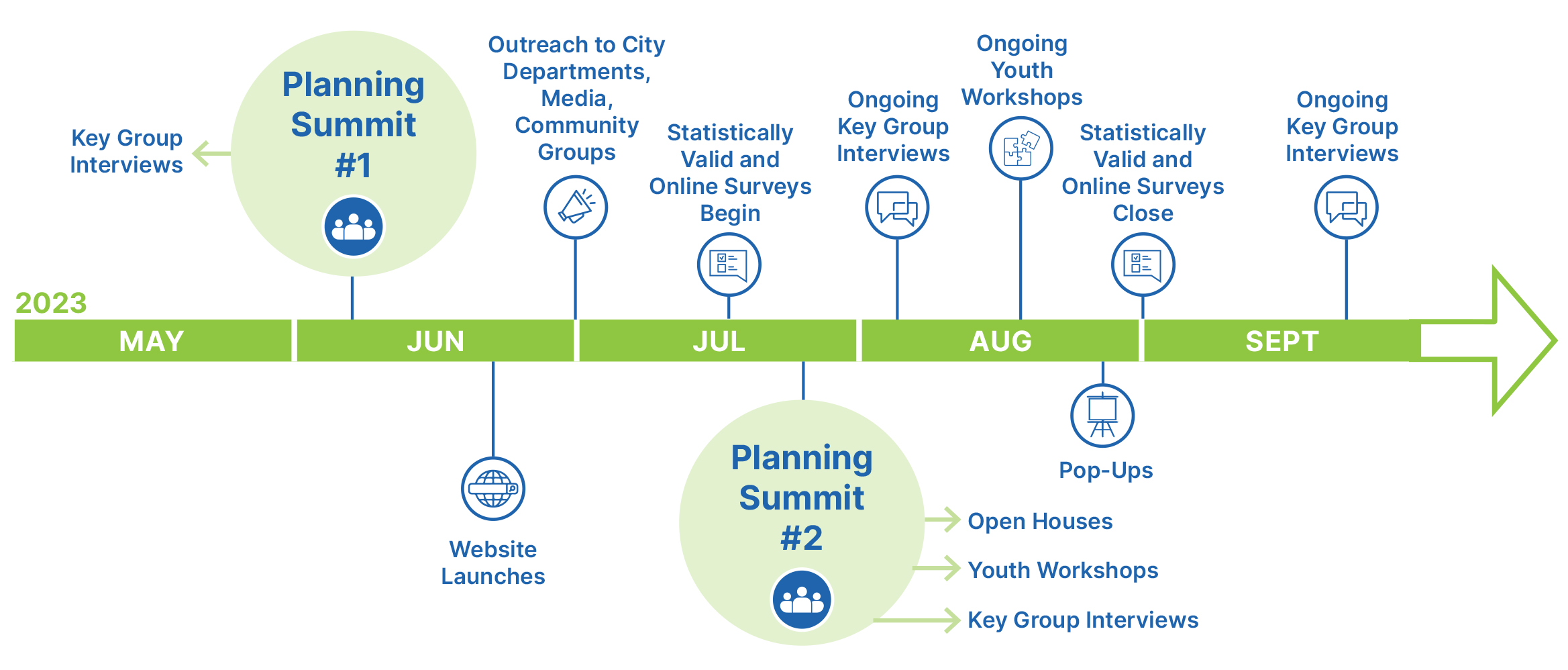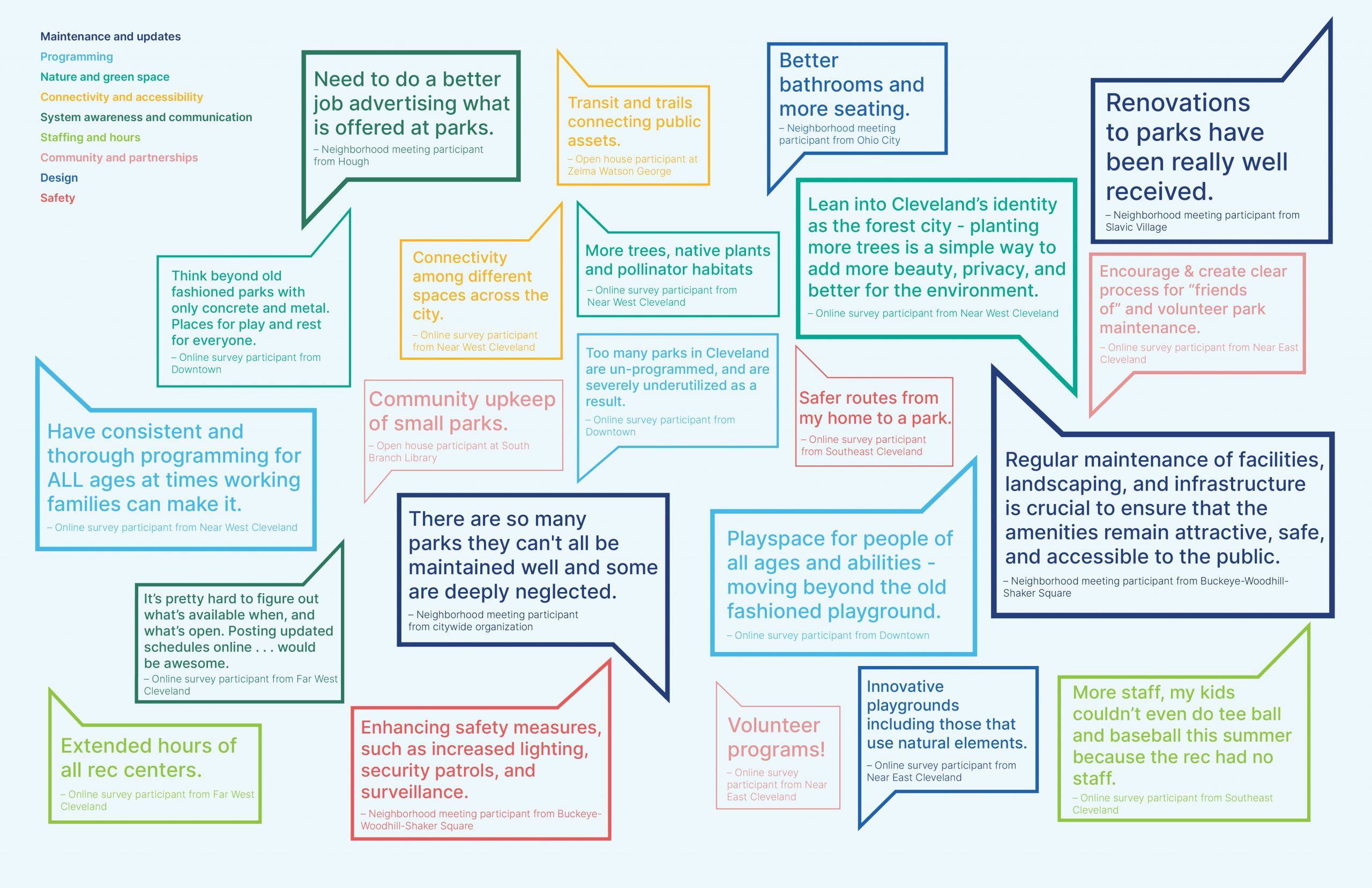To inform the future of parks and recreation in Cleveland, the Community Needs Assessment summarizes the biggest park and recreation needs identified by residents, community groups, partner organizations, and city leadership and how well they think the current system is meeting those needs.
The process of developing Cleveland’s Parks and Recreation Plan began with a number of opportunities for residents, advocates, and elected leaders to provide input. The goal of these touch points was to foster dialogue among the widest possible audience to cultivate a shared vision for the future of Cleveland’s parks and recreation facilities. This knowledge was critical to creating a plan that will guide city decisions for the next 15 years.
Explore more!

Engagement by the Numbers
The multiple methods of engagement highlighted areas of agreement—those recurring needs and themes that are most important to residents—and areas of disagreement that may indicate disparities that could inform different priorities for different planning regions.
Key Themes and Priorities
Collectively, all of the events, surveys, and workshops generated thousands of comments and data points. Throughout these community touchpoints, several key themes and priorities emerged which will help form the basis of the plan’s recommendations.
Maintenance and Updates
People are concerned that parks and recreation facilities are not being adequately maintained and updated. Half of survey respondents identified this as the top reason for not visiting parks and recreation centers more often, and 38% noted ‘poor or uncomfortable atmosphere’ as a major barrier. People noted issues around trash collection and mowing, upkeep of existing equipment and facilities, and investments to older and dated facilities. Just over 40% of survey respondents think parks are in excellent or good condition. That number drops to less than 25% for Neighborhood Resource and Recreation Centers.
Connectivity and Accessibility
Many people emphasized the importance of having a well-connected park and recreation system through a network of biking and walking trails that make traveling to facilities safe for everyone in the neighborhood. This includes access to other city facilities, as well as the waterfront and other regional recreation areas. Paved, multi-use trails were most frequently cited as the most important outdoor facility to them, selected by 41% of respondents.
Staffing and Hours
People noted inadequate staffing numbers and a lack of convenient hours at park and recreation facilities. Specifically, people noted uncertainty at Neighborhood Resource and Recreation Centers around when indoor and outdoor pools are open and a desire for senior-specific hours. Nearly half of survey respondents said they do not participate in programs because of the times the programs are offered, and close to a third of respondents said they do not visit parks and recreation centers more often because facility operating hours are not convenient.
Programming
Clevelanders love and appreciate the City’s free programming. The 57% who participated in recreation programs in the previous year rated program quality as excellent or good. There is a desire for more diverse, multigenerational, community-focused programming in parks and recreation facilities. Close to a third of survey respondents said they do not participate because their desired facility/program is not offered.
Design
People voiced the importance of basic amenities like restrooms, seating, shade/shelter, lighting, water fountains, and directional/informational signage in parks. In addition, people expressed interest in moving beyond the traditional playground and traditional field, with universally accessible playgrounds, natural playgrounds, elements that reflect the unique identity of the community, and multi-use facilities frequently mentioned.
Safety
People expressed concern around safety, both in park and recreation facilities and getting to those facilities. They cited a general lack of visible patrolling, lighting, and other preventative security as barriers to usage. Over a third (37%) of survey respondents said they did not visit parks and recreation centers more often due to a lack of visible patrolling presence.
Nature and Green Space
People expressed a desire for parks that feel more natural and incorporate sustainable elements that move beyond grass. This includes increased tree canopy, wildlife habitats, ecological diversity through native plantings, opportunities to interact with nature, and unprogrammed green space. In the survey, unprogrammed green spaces (36%) and natural areas and wildlife habitats (29%) were both in the top four most important outdoor facilities to respondents.
System Awareness and Communication
Many people said that they are unaware of the full range of services, programs, and amenities offered by the City. Respondents frequently indicated that they do not know where to go for programs or what is offered and noted that an online system for searching and registering for programs was missing. In the survey, 40% of respondents identified this as a major barrier to visiting parks and recreation centers more often.
Community and Partnerships
Community and other organizations expressed interest in developing collaborative partnerships with the City. There is energy to establish “Friends of” groups and to leverage community volunteerism, but navigating the city’s organizational structure and processes is currently difficult.
What Clevelanders Said . . .

